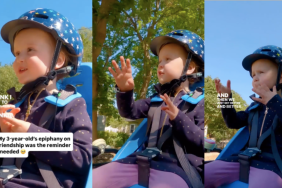For most moms, getting started is the hardest part of breastfeeding. You spend your baby’s early weeks trying to figure out what a latch is, learning how to hold your baby like a football, and struggling to interpret mysterious “pre-hunger” cues. After a while, you get the hang of things, and if you manage to navigate past the occasional clogged duct or thrush episode, breastfeeding becomes pretty smooth sailing.
For me, it was the opposite. The first few weeks were easy. It was later that it got hard.
As a newborn, my daughter easily communicated her need to nurse. She would turn her head toward me, root with her mouth, maybe suck on her fist. If I caught those early signals, many times she wouldn’t even cry.
But when she became a toddler, everything changed. One minute she’d be happily playing, and the next minute she would burst into tears, run toward me screaming, and claw at my shirt while shouting, “Milk! Milk! I want mama milk!” Which didn’t really fit my vision of a peaceful breastfeeding relationship. And even if I let her nurse, she wasn’t satisfied — she’d lie in my lap, kick my face with her feet, and then bite me.
I didn’t want to wean her yet (my goal was to continue till the World Health Organization’s recommendation of age two) but I wasn’t enjoying breastfeeding any more. That’s when I discovered the techniques that would transform our breastfeeding relationship, making it fun again for both of us.
Here’s how I survived extended breastfeeding without losing my mind.
1. Limit the frequency of sessions. Newborns need to nurse on demand. Toddlers do not. Breastfeeding for a toddler is less about nutrition and more about routine, connection, and comfort. Limiting the frequency actually made those traits more prominent — it became a special part of our morning routine and bedtime routine, instead of something we did all day long, every day. I didn’t enforce this all the time, but for the most part, this made breastfeeding something special that I could look forward to almost as much as she did. Almost.
2. Choose a specific breastfeeding location. I’m all for nursing in public, and if you’re comfortable with it, there’s no reason why you shouldn’t breastfeed wherever you like for as long as you like. But for most moms, there comes a time when breastfeeding in public starts to feel a little awkward. It may be because you feel judged because of your child’s age, or it may just be because your child insists on breastfeeding with your chest fully exposed. Instead of nursing everywhere all the time, I started limiting our sessions to a special “nursing chair.” If we were out of the house and the chair wasn’t around, I’d just tell her she had to wait till we got home.
3. Require nursing manners. It’s totally okay for newborns to cry loudly and open their mouths like hungry birds when they want to nurse. But when a toddler does the same thing? It’s annoying — and rude. Sure, a toddler is a young child who can’t be expected to behave in socially appropriate ways all of the time. But she can behave appropriately some of the time. For me, that realization was life-changing. Instead of responding to my daughter when she screamed and clawed at me, I taught her to ask politely. This taught her to be more respectful of me, and it made the whole experience more peaceful. Within a week, she’d stopped grabbing at my chest. Instead, she would walk calmly to our nursing chair and say, “Mama milk pwease?” It was so sweet, I didn’t even want to say no.
4. Limit the duration of sessions. Ending breastfeeding sessions was always a challenge with my daughter, and the shorter I tried to make them, the harder it got. I found a balance by allowing one or two of our regular sessions to go as long as she wanted (usually the morning session, when my supply was highest and I was worried I’d get mastitis if I cut her off), but for the rest of the time, I’d set a time limit. After some practice, she learned to unlatch after I counted to 10, which made it easier for me to allow occasional short comfort sessions without worrying that she’d be latched on for the next 30 minutes.
5. Listen to yourself — ignore everyone else. It’s hard to practice extended breastfeeding without encountering some criticism. In fact, if you breastfeed longer than six months, chances are good that some nosy stranger will tell you that’s disgusting and wrong. But the truth is, nobody else’s opinion matters. There’s only one person whose opinion really matters about your breastfeeding, and that’s yours. If you believe that extended breastfeeding is the right thing for you and your child, then do it — and enjoy it. I got plenty of weird looks during my years of toddler breastfeeding, but no one ever confronted me. I suspect it was because whenever a stranger looked surprised that I was breastfeeding, I looked them in the eye and smiled. It turns out that a lot of people who might otherwise be critical are disarmed by a friendly smile. It’s like they figure if you’re so confident and certain, you must be doing the right thing.
And you know what? You are.
It’s one of the most beautiful things about breastfeeding: It doesn’t have to be all or nothing. Just as you can both breastfeed and bottle-feed when your baby is little, you can practice extended breastfeeding without keeping your body on demand 24/7. And by setting limits that make extended breastfeeding comfortable for you, you just might discover that the only hard part about toddler nursing is deciding that you want to stop.
Photo: Getty








